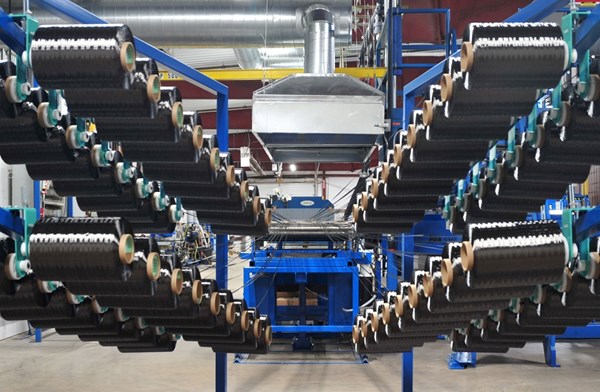Long Carbon Fiber Reinforced Composites Gain Interest
PlastiComp, for one, has added production capability to meet increasing demand.
That thermoplastic composites have been on a thriving road is no surprise. The long fiber thermoplastics (LFT) arena has been one of great interest, starting with long glass fibers, expanding to both long carbon fiber and hybrids of glass/carbon. Often selected for its high strength-to-weight ratio, which makes it an ideal material choice for applications with structural requirements that also need to be lightweight—long carbon fiber composites offer mechanical performance equivalent to aluminum while providing design dependent weight reductions up to 50% (read more about thermoplastics composites at PT sister publication, CompositesWorld).
One leading compounder in this arena is PlastiComp, Inc., Winona, Minn., and the company continues to innovate and expand its production capabilities. The company makes a point of noting that carbon fiber’s extensive use in aerospace and other advanced industries has given it a “high-tech” perception, which other markets are now taking advantage of to promote their products to consumers.
Initiatives to replace metals for weight reduction have made materials containing carbon fiber a favorite of sporting goods manufacturers where it helps reduce participant fatigue, and the transportation sector where it lowers vehicle mass to increase fuel economy and curtail engine emissions.
PlastiComp recently announced that it has completed installation of an additional pultrusion line dedicated to manufacturing long carbon fiber reinforced thermoplastic composite pellets at its Winona manufacturing location. The company’s initial production line dedicated to producing long carbon fiber composite pellets was brought on stream in 2014. The new line will triple the company’s capacity for long carbon fiber products to help ensure uninterrupted supply to its industry partners.
The company operates four other pultrusion lines to manufacture its long glass fiber products. It also has a long fiber composites product line that combines glass fiber and carbon fiber into one pellet. These hybrid long glass+carbon products have been positioned to bridge the performance and price gap between all-glass fiber and all-carbon fiber reinforced composite materials. All of these LFT thermoplastic composites are sold under the Complet trade name. In the case of the carbon fiber reinforced composites, they are available with 15 to 50-percent long carbon fiber reinforcement combined into a broad range of thermoplastic matrices ranging from PP to PEEK.
To provide a safe operating environment and minimize downtime, PlastiComp produces its carbon fiber composites on pultrusion lines located in self-contained areas equipped with isolated electrical and handling systems. Said Eric Wollan, v.p. and COO at PlastiComp:
“From a pultrusion perspective, carbon fiber’s small filament diameter and conductivity make it a little more challenging to manufacture composite pellets than other types of fiber…using our specialized equipment, PlastiComp is able to completely melt impregnate continuous tows of carbon fiber with 12,000 to 50,000 filaments. This capability allows us to offer a broad range of composite material solutions which we tailor to meet customer specific design and performance requirements.”

Related Content
-
Prices of Volume Resins Drop
Price relief is expected to continue through the fourth quarter for nine major commodity and engineering resins, driven by widespread supply/demand imbalances.
-
The Fantasy and Reality of Raw Material Shelf Life: Part 1
Is a two-year-old hygroscopic resin kept in its original packaging still useful? Let’s try to answer that question and clear up some misconceptions.
-
Tracing the History of Polymeric Materials: Acetal
The road from discovery in the lab to commercial viability can be long, and this was certainly the case for acetal polymers.
















